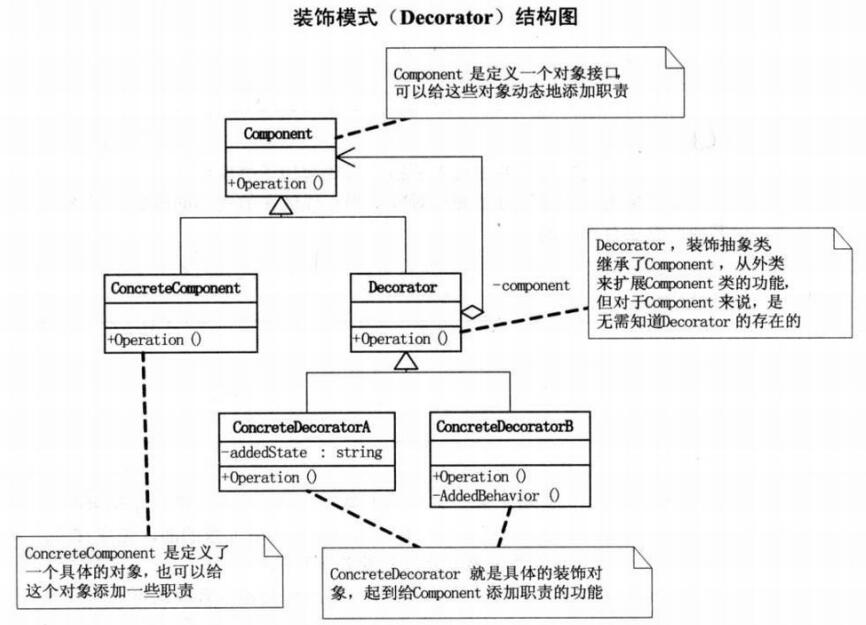装饰者模式,动态地给一个对象添加一些额外的职责,就增加功能来说,装饰模式比生成子类更为灵活。装饰者模式结构图如下所示:
 Component是定义一个对象接口,可以给这些对象动态地添加职责。ConcreteComponent是定义了一个具体的对象,也可以给这个对象添加一些职责。Decorator,装饰抽象类,继承了Component。从外类来扩展Component类的功能,但对于Component来说,是无需知道Decorator的存在的。至于ConcreteDecoartor就是具体的装饰对象,起到给Component添加职责的功能。
Component是定义一个对象接口,可以给这些对象动态地添加职责。ConcreteComponent是定义了一个具体的对象,也可以给这个对象添加一些职责。Decorator,装饰抽象类,继承了Component。从外类来扩展Component类的功能,但对于Component来说,是无需知道Decorator的存在的。至于ConcreteDecoartor就是具体的装饰对象,起到给Component添加职责的功能。
Component类代码:
public abstract class Component {
public abstract void Operation();
}ConcreteComponent类:
public class ConcreteComponent extends Component {
@Override
public void Operation() {
System.out.println("具体对象的操作");
}
}Decorator类代码:
public class Decorator extends Component {
protected Component component;
public void setComponent(Component component) {
this.component = component;
}
@Override
public void Operation() {
if(component!=null)
component.Operation();
}
}ConcreteDecorator类代码:
public class ConcreteDecoratorA extends Decorator {
private String addedState;
@Override
public void Operation() {
super.Operation();
addedState="New State";
System.out.println("具体装饰对象A的操作");
}
}
class ConcreteDecoratorB extends Decorator{
@Override
public void Operation() {
super.Operation();
AddedBehavior();
System.out.println("具体装饰对象B的操作");
}
private void AddedBehavior(){
}
}如果只有一个ConcreteComponent类而没有抽象的Component类,那么Decorator类可以是ConcreteComponent的一个子类。如果只有一个ConcreteDecorator类,那么就没有必要建立一个单独的Decorator类,而可以把Decorator和ConcreteDecorator的责任合并成一个类。
装饰者是为已有功能动态的添加更多的功能的一种方式,当系统需要新功能的时候,是向旧的类中添加新的代码。这些新加的代码通常装饰了原有类的核心职责或主要行为。装饰者模式把每个要装饰的功能放在单独类中,并让这个类包装它所要装饰的对象,因此,当需要执行特殊行为时,客户代码就可以在运行时根据需要有选择地、按顺序地使用装饰功能包装对象。
装饰者模式优点:
- 装饰者模式与继承关系的目的都要扩展对象的功能,但是装饰模式可以提供比继承更多的灵活性。装饰者模式允许系统动态决定“贴上”一个需要的“装饰”,或者除掉一个不需要的“装饰”。继承关系则不同,继承关系是静态的,它在系统运行前就决定了
- 通过使用不同的具体装饰类以及这些装饰类的排列组合,设计师可以创造出很多不同行为的组合
装饰者模式缺点: 由于使用装饰者模式,可以比使用继承关系需要较少数目的类。使用较少的类,当然使设计比较易于进行。但是,在另一个方面,使用装饰模式会产生比使用继承关系更多的对象。更多的对象会使得查错变得困难,特别是这些对象看上去都很相像。
装饰者模式就是尽量使用组合,而非使用继承。
